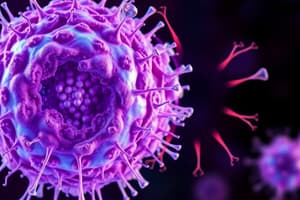Podcast
Questions and Answers
What is a key characteristic that differentiates prokaryotic cells from eukaryotic cells?
What is a key characteristic that differentiates prokaryotic cells from eukaryotic cells?
- Eukaryotes have membrane-bound organelles. (correct)
- Prokaryotes contain multiple chromosomes.
- Prokaryotes have a cell wall made of cellulose.
- Eukaryotes multiply solely by binary fission.
Which process is used by prokaryotic cells for reproduction?
Which process is used by prokaryotic cells for reproduction?
- Budding
- Meiosis
- Binary fission (correct)
- Mitosis
What type of genetic material organization is found in prokaryotic cells?
What type of genetic material organization is found in prokaryotic cells?
- Circular DNA in a nucleoid. (correct)
- Chromatin arranged in a nucleus.
- Linear DNA organized in chromosomes.
- Plasmids encased in membranes.
In terms of cellular organization, what separates the cytoplasm in eukaryotic cells?
In terms of cellular organization, what separates the cytoplasm in eukaryotic cells?
Which statement about prokaryotes and eukaryotes is true?
Which statement about prokaryotes and eukaryotes is true?
What is a distinctive feature of the cell wall in prokaryotic cells?
What is a distinctive feature of the cell wall in prokaryotic cells?
What is the role of chromatin in eukaryotic cells during cell division?
What is the role of chromatin in eukaryotic cells during cell division?
Which of the following structures is present in eukaryotic cells but absent in prokaryotic cells?
Which of the following structures is present in eukaryotic cells but absent in prokaryotic cells?
Eukaryotic cells always have a real nucleus surrounded by a nuclear envelope.
Eukaryotic cells always have a real nucleus surrounded by a nuclear envelope.
Prokaryotes are consistently found as multicellular organisms.
Prokaryotes are consistently found as multicellular organisms.
The division process in eukaryotes is called binary fission.
The division process in eukaryotes is called binary fission.
Prokaryotic cells contain well-defined cytoplasmic organelles separated by membranes.
Prokaryotic cells contain well-defined cytoplasmic organelles separated by membranes.
The outer structure of prokaryotic cells includes a cell wall that contains N-acetyl muramic acid.
The outer structure of prokaryotic cells includes a cell wall that contains N-acetyl muramic acid.
Protozoa are categorized as multicellular eukaryotic organisms.
Protozoa are categorized as multicellular eukaryotic organisms.
Eukaryotes can be either unicellular or pluricellular organisms.
Eukaryotes can be either unicellular or pluricellular organisms.
Mesosomes are structures found in eukaryotic cells for cytoplasmic extensions.
Mesosomes are structures found in eukaryotic cells for cytoplasmic extensions.
Flashcards
Prokaryotes
Prokaryotes
Organisms whose cells lack a true nucleus and other membrane-bound organelles.
Eukaryotes
Eukaryotes
Organisms whose cells have a true nucleus and other membrane-bound organelles.
Nucleoid
Nucleoid
The region in a prokaryotic cell where genetic material is located, but not enclosed by a membrane.
Binary Fission
Binary Fission
Signup and view all the flashcards
Mitosis
Mitosis
Signup and view all the flashcards
Cytoplasmic Organelles
Cytoplasmic Organelles
Signup and view all the flashcards
Prokaryotic Cell Wall
Prokaryotic Cell Wall
Signup and view all the flashcards
Plant Cell Wall
Plant Cell Wall
Signup and view all the flashcards
Indirect Division
Indirect Division
Signup and view all the flashcards
Cell Wall
Cell Wall
Signup and view all the flashcards
Study Notes
Prokaryotic vs. Eukaryotic Cells
- Two main cell types: Prokaryotes (bacteria, blue-green algae) and Eukaryotes (plants, animals, humans).
- Prokaryotes are unicellular organisms.
- Eukaryotes can be unicellular (protozoa) or multicellular (animals, plants).
Five Key Differences
- Nucleus: Eukaryotes have a true nucleus enclosed by a nuclear envelope and containing a set number of chromosomes. Prokaryotes lack a true nucleus, instead having a nucleoid region. The nucleoid is a structure with a single, tightly packed DNA molecule (the prokaryotic chromosome).
- Cell Division: Prokaryotes reproduce via binary fission. Eukaryotes reproduce via indirect division (mitosis and meiosis). During eukaryotic division, chromatin condenses causing chromosomes to become visible as structures.
- Cytoplasmic Organelles: Eukaryotes have numerous membrane-bound organelles (e.g., mitochondria, lysosomes, peroxisomes, Golgi apparatus, endoplasmic reticulum), partitioned from the rest of the cytoplasm. Prokaryotes do not have membrane-bound organelles. Their cytoplasm is not partitioned.
- Cell Wall: Prokaryotic cell walls contain N-acetyl muramic acid. Eukaryotic cell walls (like those of plants) are composed of cellulose and differ structurally from prokaryotic cell walls.
- Plasma Membrane: Both have a plasma membrane. Prokaryotes also have possible cytoplasmic extensions called mesosomes.
Eukaryotic Cytoplasm
- Cytosol: The liquid component of the cytoplasm; it contains organelles and the cytoskeleton which maintains cell shape and allows for movement.
- Organelle Membranes: Organelle membranes partition the cytoplasm into spaces with defined compositions. Specific enzymatic processes happen in different compartments under different conditions.
- Increased Surface Area: Organelle membranes increase the surface area for membrane enzymes involved in reactions.
- Cytoplasmic Volume: The cytosol takes up the largest proportion of the cellular volume, followed by mitochondria and the endoplasmic reticulum.
Studying That Suits You
Use AI to generate personalized quizzes and flashcards to suit your learning preferences.




